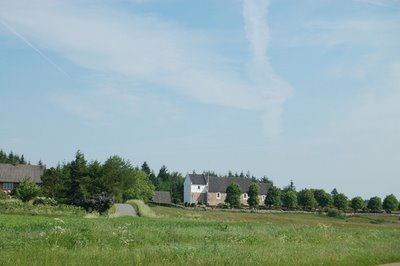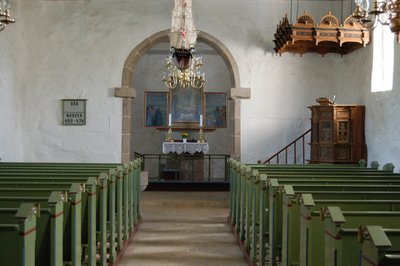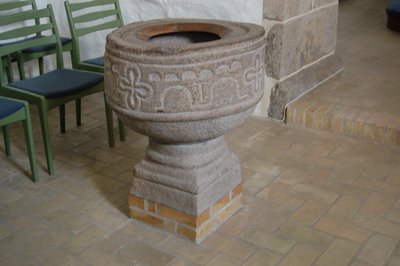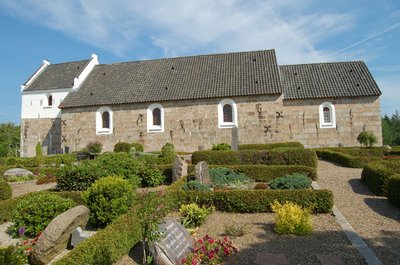
Hjardemål Church , Thy
a few km south of the North Sea by Vigsø Bugt

Interior.

The Romanesque granite font is of Thybo-type.

A back entrance to the church yard.

A lake with water lilies in Hjardemål Dune Plantation.
The church has a Romanesque choir and nave, a Late Gothic western tower and a southern porch from the 1800s. The Romanesque building is in granite ashlars. Both doors are preserved , the south door is in use, the north door stands with an inside niche. The east window of the choir is an inside niche, while the round arched window to the north is well preserved. The nave has kept two original windows. In several places in the walls are ashlars with stone mason marks.
The unusual tall and heavy tower from about 1500 is built in monk bricks above re-used ashlars. The tower was a light house in its earlier days, but since the plantations grew up, it is invisible from the sea.
The church has beamed ceilings. The triumph arch has profiled 'kragsten'. The altar piece is made of three point arched fields with paintings from 1837. Above the altar piece is placed a square sounding board from ab. 1600. A romanesque granite font of thybo-type . A south German baptismal basin from ab. 1575. The pulpit is from ab. 1600. The sounding board above the pulpit is contemporary . The gallery in the western part of the church is from ab. 1600. The church bell from 1513.
Epitaph ab. 1650 on Chr. Nielsen Morsing, + 1673, a joinery in rural Renaissance. Gravestone 1) Lauridtz Jensen Koch, + 1691 and wife, 2) parish priest Peder Nielsen Sengeløs, + 1699.
Names in the Middle Ages and the 1600s:
Hjaremål/Hjardemål (* 1436 Hiarmull, 1477 Hormol, 1505 Hiermall, 1664 Hiarmall);
Kåse (*1435 Kaasse); Tved (1600 Tuedt); Skiverklit (1470 Skyrdklitte, Skywrklitte, 1483 Skørclith); Blovsgaarde (1602 Blagsgaardt, 1664 Blochsgaard); Rimmegaard (1664 Rimergaard, 1688 Paa Remmen); Rovergaard ( 1638 Rovad); Oddersbøl (1600 Odersbøll); Madsbøl (1477 Marssbol); Langhov( 1603 Langschou, 1664 Paa Haw).
Oddersbøl ( in 1686 belonging to Vesløsgaard), was owned after 1686 by Laurids Koch (+1691) and then his widow Anne Sørensdatter Guldager, whose daughter Anne brought it to her husband Casper Preetzmann. In 1752 it belonged to his son Erik Zacharias Preetzmann (+1772), whose widow Margrethe Hesseldahl kept it until her death in 1796.
Esper Hvas of Tved (the family Hvas of Skjortholt) is mentioned in 1568.
In 1477 Per Nielsen of Langvad had estate Marssbol in pawn for 16 mark dansk by Otto Stampe (the family Stampe of Klarupgård) and Ingerd Lauridsdattter (maybe O. Stampe's wife), whose rightful inheritance it was. In 1505 Otto Stampe's son Mogens Stampe sold "Morsbooel" to Margrethe Turesdatter (Bjelke) of Ågård.
In 1472 væbner Michel Terkildsen of Korssze is mentioned.
The house Voldum is the rest of a village by the same name (1508 Vollom) In the parish is in 1552 and later mentioned the farm Medelklit, ab. 1600 the farms Ved Kæret (1600 Vid Kieridt) and Fladskæret (1603 Fladtzkeridt), in 1664 the farms Wed Blød and Lille Odersbøl.
Listed prehistorics:
Two hills of which one at Tved is large. Demolished hills not noted, but two Bronze Age grave findings are known, both with a dagger and a pålstav (axe-type). At Korsø were found several graves, built in limestone, with graves from Roman Iron Age.
The parish - being only a few km from the North Sea - has suffered extremely from sand drift. But the large Hjardemål Dune Plantation is not only sand. There are several small lakes.
Source: Trap Danmark, Thisted amt, 1961
photo 15 June 2006: grethe bachmann






